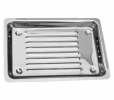OBJECTIVES:
Although stress is prevalent amongst dentists, there is a paucity of data on the impact of stressors on dentists' clinical performance. To address this gap in the literature, the aim of the present study was to explore the role of time pressure, representing one common stressor, on dentists' radiographic diagnostic performance.
METHODS:
Forty dentists were randomised to examine and provide a radiographic report on two sets of radiographs (six bitewings in each set) under two conditions on a cross-over basis: time-pressure vs. no-time-pressure. The radiographic report of an experienced consultant was considered the gold standard against which participants diagnostic decisions were compared to calculate sensitivity and specificity. Participants rated their stress after each experimental condition using a 100 mm visual analogue scale (VAS).
RESULTS:
The VAS scores for stress were significantly higher in the time pressure condition vs. no time pressure condition (mean: 55.78 versus 10.73, p < 0.0001), indicating that the time pressure acted as a source of stress. Dentists' diagnostic performance was affected; the sensitivity was significantly lower under time pressure (median: 0.50 versus 0.80, p < 0.0001), but by contrast, the median diagnostic specificity was 1.00 under both conditions.
CONCLUSIONS:
Time pressure negatively impacts one aspect of dentists' diagnostic performance, namely sensitivity (increased diagnostic errors and omissions of pathology), which can potentially affect patient safety and the quality of care delivered. However, time pressure was found to have less influence on diagnostic specificity.
CLINICAL SIGNIFICANCE:
The present study demonstrated a significant deterioration of dentists' diagnostic performance (sensitivity) under time-pressure when examining bitewing radiographs. Diagnostic errors may put patient safety at risk, with patients potentially being harmed if pathology is missed. Such errors can have medicolegal implications on the dentists' practice.


